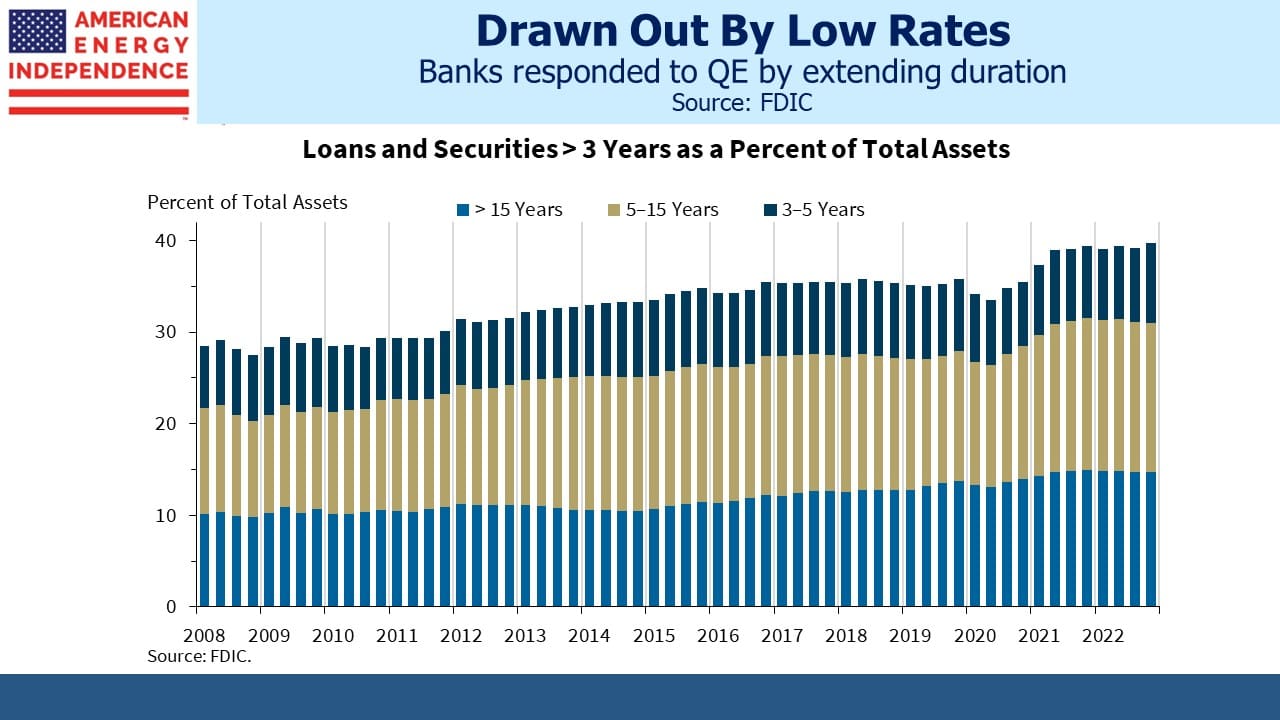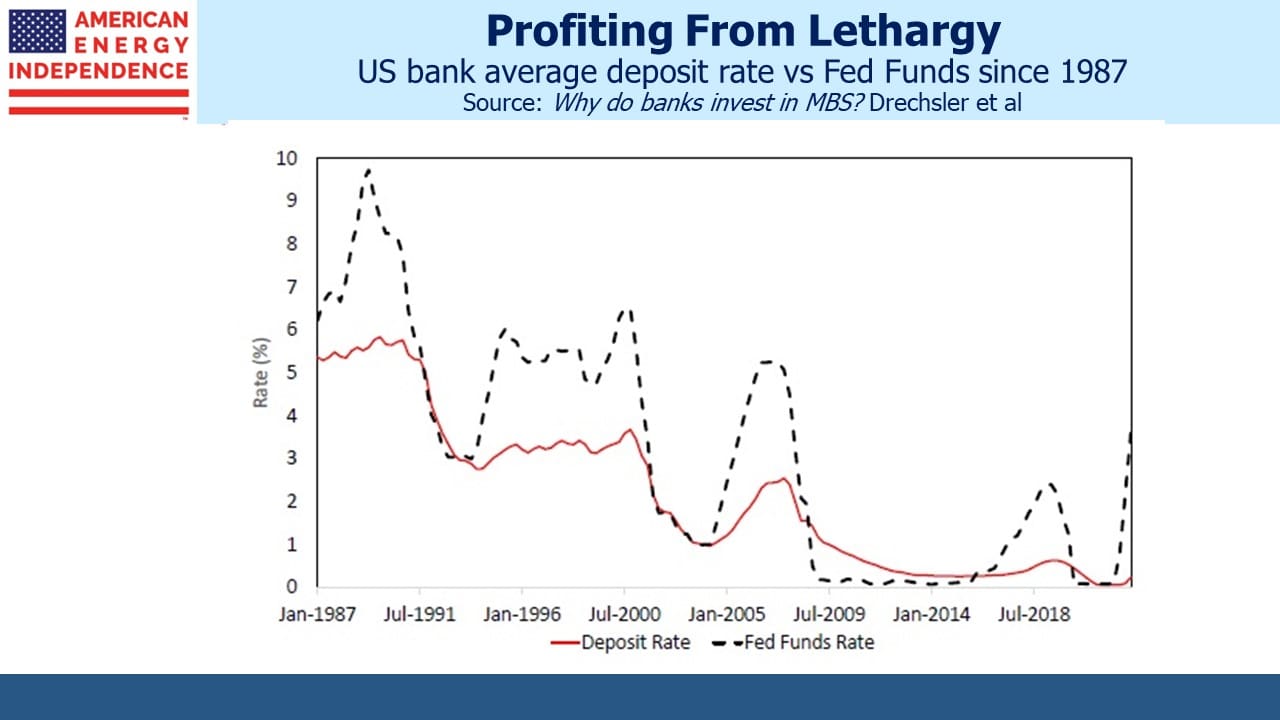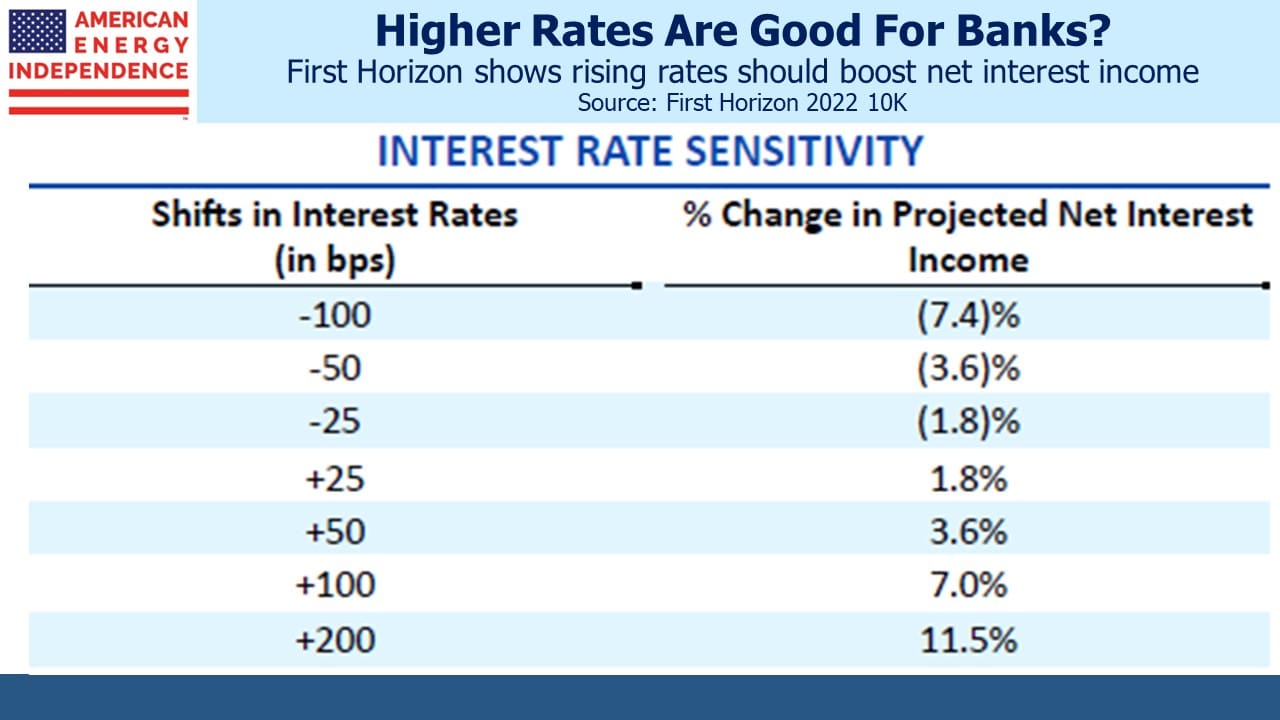Why Keep Money At A Bank?

/
I looked through First Horizon Bank’s (FHN) 10K last week. They were in the news because Toronto Dominion (TD) canceled their merger agreement due to uncertainty about when they might receive regulatory approval. FHN’s stock slumped to below $10. The merger price, agreed in February of last year, was $25.
FHN CEO Bryan Jordan told CNBC that he had never been able to ascertain from TD the precise nature of the regulatory impediment that TD was facing. Nonetheless TD had second thoughts and regarded the $200 million break-up fee as better business than paying $13.45BN for a bank whose market cap is now less than half that.
FHN reported $1,159 million in pre-tax income last year, down modestly from 2021’s figure of $1,284 million. This excludes unrealized losses on their securities portfolio and hedges of $1,080 million, reported under Other Comprehensive Income. Including them would have wiped out the whole year’s profit. Perhaps this convinced TD to walk away.
When interest rates depress the value of bonds, banks don’t have to record unrealized losses as long as they have the intention and ability to hold them until maturity. Defenders of this approach argue that higher rates benefit the liability side of a bank’s balance sheet because deposit rates typically rise less than Fed Funds. Revaluing the assets and not the liabilities would present an inaccurate picture. However, it assumes the deposits won’t leave. Banks rely on history to assess the stickiness of their deposit base. Sometimes, as with Silicon Valley and First Republic, they’re wrong.
Deposits are sticky because savers are lazy or unsure how to access better rates using treasury bills. Banks are relying on this historic behavior repeating to fund their underwater bonds with uncompetitive deposit rates.
It costs money to provide banking services, and fees are highly unpopular. So in effect the fees are bundled into the service. Banks don’t pay much interest. That’s the fee.
Most of us weren’t watching while banks steadily loaded up on interest rate risk following the 2008 Great Financial Crisis (GFC). Quantitative Easing (QE) was intended to stimulate demand for capital by suppressing rates. But what’s good for borrowers can be bad for lenders. Many banks responded to low rates by increasing fixed rate commercial loans and mortgages. QE was supposed to encourage borrowing, but it also encouraged more long-term lending from banks.
FHN is a portfolio of underwater bonds and loans whose funding relies on uninformed depositors willing to leave money with them at low rates. Banks have always paid uncompetitive rates on savings. It’s part of the business model. It’s why banks traditionally do well when rates go up. FHN’s 10K shows that their Net Interest Margin (NIM) improves with higher rates. In 1Q23 earnings released on Thursday NIM deteriorated in spite of continued Fed tightening. And last year higher rates cost FHN over $1BN.
Like most banks, FHN assumes their deposits are unlikely to leave for higher rates elsewhere. But is that about to change? Silicon Valley caused people to ask two questions: (1) Is my money safe? (2) What interest is it earning?
The Fed has played a significant role in this. Because of QE investors and banks have faced unattractively low rates for years. The Fed was slow to recognize the risk of inflation. As a result, they raised rates faster than many expected. And they didn’t consider the impact on the banking system, which they regulate, of higher rates.
The Fed added to the pressure on regional banks by raising rates last week, further highlighting the uncompetitive rates paid on deposits. An increase in the FDIC cap above $250K would slow the outflow, but what banks really need is lower short term rates. Heavy reliance on large uninsured deposits isn’t every bank’s problem. But holdings of low fixed rate securities and loans are widespread.
America has over 4,000 banks. The figure has been declining for decades. We had twice that number in 1999. This abundance is a uniquely American construct, a legacy of state banking regulations which used to impede expansion. Often the small bank strategy was to be acquired by a bigger one. Today that’s only happening as a distressed sale. We’re learning that there aren’t 4,000 competent chief risk officers employed in the banking system.
Today, why would you deposit cash at First Horizon or indeed any bank beyond the amount you need to keep in a checking account? Fees are disguised as paltry rates on deposits. Banks have insulted our intelligence in this way for years. Rapid Fed tightening is illuminating it.
The market is priced for the Fed to provide banking relief in the form of lower rates, this year. The FOMC is in denial – slow as usual to comprehend what’s happening. The regional banking crisis won’t end until the Fed gets it. In the meantime, loan growth at all but the biggest institutions will be constrained by the risk of a rapid loss of deposits and recourse to wholesale funding in the Fed Funds market. Few banks can profitably fund their assets at 5%.
This is why you should bet on 4% inflation instead of 2%. It’s the path of least resistance.
We have three funds that seek to profit from this environment:

Important Disclosures
The information provided is for informational purposes only and investors should determine for themselves whether a particular service, security or product is suitable for their investment needs. The information contained herein is not complete, may not be current, is subject to change, and is subject to, and qualified in its entirety by, the more complete disclosures, risk factors and other terms that are contained in the disclosure, prospectus, and offering. Certain information herein has been obtained from third party sources and, although believed to be reliable, has not been independently verified and its accuracy or completeness cannot be guaranteed. No representation is made with respect to the accuracy, completeness or timeliness of this information. Nothing provided on this site constitutes tax advice. Individuals should seek the advice of their own tax advisor for specific information regarding tax consequences of investments. Investments in securities entail risk and are not suitable for all investors. This site is not a recommendation nor an offer to sell (or solicitation of an offer to buy) securities in the United States or in any other jurisdiction.
References to indexes and benchmarks are hypothetical illustrations of aggregate returns and do not reflect the performance of any actual investment. Investors cannot invest in an index and do not reflect the deduction of the advisor’s fees or other trading expenses. There can be no assurance that current investments will be profitable. Actual realized returns will depend on, among other factors, the value of assets and market conditions at the time of disposition, any related transaction costs, and the timing of the purchase. Indexes and benchmarks may not directly correlate or only partially relate to portfolios managed by SL Advisors as they have different underlying investments and may use different strategies or have different objectives than portfolios managed by SL Advisors (e.g. The Alerian index is a group MLP securities in the oil and gas industries. Portfolios may not include the same investments that are included in the Alerian Index. The S & P Index does not directly relate to investment strategies managed by SL Advisers.)
This site may contain forward-looking statements relating to the objectives, opportunities, and the future performance of the U.S. market generally. Forward-looking statements may be identified by the use of such words as; “believe,” “expect,” “anticipate,” “should,” “planned,” “estimated,” “potential” and other similar terms. Examples of forward-looking statements include, but are not limited to, estimates with respect to financial condition, results of operations, and success or lack of success of any particular investment strategy. All are subject to various factors, including, but not limited to general and local economic conditions, changing levels of competition within certain industries and markets, changes in interest rates, changes in legislation or regulation, and other economic, competitive, governmental, regulatory and technological factors affecting a portfolio’s operations that could cause actual results to differ materially from projected results. Such statements are forward-looking in nature and involves a number of known and unknown risks, uncertainties and other factors, and accordingly, actual results may differ materially from those reflected or contemplated in such forward-looking statements. Prospective investors are cautioned not to place undue reliance on any forward-looking statements or examples. None of SL Advisors LLC or any of its affiliates or principals nor any other individual or entity assumes any obligation to update any forward-looking statements as a result of new information, subsequent events or any other circumstances. All statements made herein speak only as of the date that they were made. r
Certain hyperlinks or referenced websites on the Site, if any, are for your convenience and forward you to third parties’ websites, which generally are recognized by their top level domain name. Any descriptions of, references to, or links to other products, publications or services does not constitute an endorsement, authorization, sponsorship by or affiliation with SL Advisors LLC with respect to any linked site or its sponsor, unless expressly stated by SL Advisors LLC. Any such information, products or sites have not necessarily been reviewed by SL Advisors LLC and are provided or maintained by third parties over whom SL Advisors LLC exercise no control. SL Advisors LLC expressly disclaim any responsibility for the content, the accuracy of the information, and/or quality of products or services provided by or advertised on these third-party sites.
All investment strategies have the potential for profit or loss. Different types of investments involve varying degrees of risk, and there can be no assurance that any specific investment will be suitable or profitable for a client’s investment portfolio.
Past performance of the American Energy Independence Index is not indicative of future returns.







Excellent assessment. “Fees are disguised as paltry rates on deposits.” Precisely.
Agreed. Inflation will remain elevated for three reasons that will not change. Energy transition. Demographics. Death of globalization.